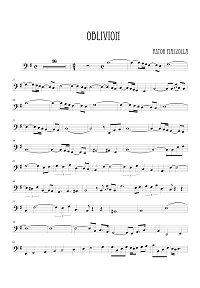Piazzolla - Oblivion for cello and piano
Piazzolla - Oblivion for cello and piano. You can download the PDF sheet music Piazzolla - Oblivion for cello and piano on this page. This is a cello transcription of this famous Astor Piazzolla's composition. This bright and shiny composition is very soulful and spiritual, and have a wide range of different sound colors. Piazzolla knew that it was precisely in this type of music where his own torment and depression found its outlet in the heart-rending strains of the bandoneon, and he longed to weave that music into something wider and allusive while leaving its essential fabric intact. Piazzolla realized that to do so depended most of all on the blend of measure and rhythm, balance and freedom. All this can be seen it this cello transcription of Oblivion.
To download PDF, click the "Download PDF" button below the appropriate sheet music image.
To view the first page of Piazzolla - Oblivion for cello and piano click the music sheet image.
|
| PDF format sheet music |
|
|
|
Cello part: 2 pages. 30 K
|
Piano part: 4 pages. 222 K
|
 |
 |
|
|
| Download PDF (14.99
€) |
Download PDF (14.99
€) |
|
| Piazzolla's nuevo tango was distinct from the traditional tango in its incorporation of elements of jazz, its use of extended harmonies and dissonance, its use of counterpoint, and its ventures into extended compositional forms. It is precisely this success, and individuality, that makes it hard to pin down where particular influences reside in his compositions, but some aspects are clear. The use of the passacaglia technique of a circulating bass line and harmonic sequence, invented and much used in 17th- and 18th-century baroque music but also central to the idea of jazz "changes", predominates in most of Piazzolla's mature compositions. Another clear reference to the baroque is the often complex and virtuosic counterpoint that sometimes follows strict fugal behavior but more often simply allows each performer in the group to assert his voice. A further technique that emphasises this sense of democracy and freedom among the musicians is improvisation, that is borrowed from jazz in concept, but in practice involves a different vocabulary of scales and rhythms that stay within the parameters of the established tango sound-world. Pablo Ziegler has been particularly responsible for developing this aspect of the style both within Piazzolla's groups and since the composer's death. |
|